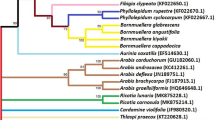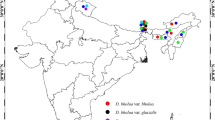Abstract
Memecylon (Melastomaceae) is a large genus of the Old-World predominantly woody species. Many species of Memecylon are used for timber, ornamental and medicinal purposes. The objective of the present study was to undertake a phylogenetic analysis of Indian Memecylon based on nuclear ribosomal DNA internal transcribed spacer (nrDNA-ITS) and rbcL sequence data. Sampling included 26 species and one variety (20 endemics) representing 67% of the total Indian species. Molecular phylogeny data for analysed species revealed that the Indian Memecylon is monophyletic. Monophyly is strongly supported in the ITS, rbcL and ITS + rbcL combined analyses. Memecylon species are grouped in a major clade with strong support in ITS sequence data and moderate support in combined ITS + rbcL analyses.






Similar content being viewed by others
References
Amarasinghe P., Joshi S., Page N., Wijedasa L. S., Merello M., Kathriarachchi H. et al. 2021 Evolution and biogeography of Memecylon. Am. J. Bot. 108, 1–19.
Bremer K. 1979 Taxonomy of Memecylon (Melastomataceae) in Ceylon. Opera Bot. 50, 1–32.
Bremer K. 1983 Taxonomy of Memecylon (Melastomataceae) in Borneo. Opera Bot. 69 147.
Bremer K. 1988 Melastomataceae. In A revised handbook to the flora of Ceylon (eds. M. D. Dussanayake and F. R. Fosberg), vol. 6. Balkema, Rotterdam.
CBOL Plant Working Group. 2009 A DNA Barcode for Land Plants. Proc. Natl. Acad. Sci. U.S.A. 106, 12794–12797. https://doi.org/10.1073/pnas.0905845106
Clausing G. and Renner S. S. 2001 Molecular phylogenetics of Melastomataceae and Memecylaceae: Implications for character evolution. Am. J. Bot. 88, 486–498.
Clark C. B. 1879 Melastomataceae. In The Flora of British India, vol. 2 (ed. F. Hook), pp. 512–565. Reeve, London.
Cogniaux C. A. 1891 Melastomaceae. In Monographiae phanerogamarum, vol. 7 (eds. Candolle, A. de. and Candolle C. de). G. Masson. Paris (https://doi.org/10.5962/bhl.title.45961).
Das M. D., Maity D. and Parmanik A. 2016 Typification of seven names of Indian Memecylon (Melastomataceae). Kew Bull. 71, 48.
Das M. D., Giri G. S., Parmanik A. and Maity D. 2018a Taxonomic status of Memecylon petiolatum Trimen ex Alston (Melastomataceae) and its extension of distribution to India. Feddes Repert. 129, 51–57.
Das M. D., Parmanik A. and Maity D. 2018b Nomenclatural notes on some Indian species of Memecylon. Ann. Bot. Fenn. 55, 149–154.
de Wilde J. J. F. E., Hughes M., Rodda M. and Thomas D. C. 2011 Pliocene intercontinental dispersal from Africa to Southeast Asia highlighted by the new species Begonia afromigrata (Begoniaceae). Taxon 60, 1685–1692.
Donoghue M. J. 2008 A phylogenetic perspective on the distribution of plant diversity. Proc. Natl. Acad. Sci. USA 105(suppl. 1), 11549–11555.
Drummond A. J., Ashton B., Buxton S., CheungM., Cooper A., Heled J. et al. 2010 Geneious v. 5.1 (available at http://www.geneious.com).
Engler A. 1921 Die Pflanzenwelt Afrikas: Insbesondere seiner tropischen Gebiete; Grundzüge der Pflanzenverbreitung in Afrika und die Charakterpflanzen Afrikas, Band 3, Heft 2, Charakterpflanzen Afrikas. Die Vegetation der Erde: Sammlung pflanzengeographischer Monographien 9. Leipzig: Wilhelm Engelmann. https://doi.org/10.5962/bhl.title.50144
Forrest L. L., Hughes M. and Hollingsworth P. M. 2005 A phylogeny of Begonia using nuclear ribosomal sequence data and morphological characters. Syst. Bot. 30, 671–682.
Gamble J. S. 1919 Decades kewensis XCII–XCIII. Bull. Misc. Inform. Kew 1919, 221–231.
Goldenberg R., Penneys D. S., Almeda F., Judd W. S. and Michelangeli F. A. 2008 Phylogeny of Miconia (Melastomataceae): Patterns of stamen diversification in a megadiverse neotropical genus. Int. J. Plant Sci. 169, 963–979.
Hughes M. and Wijedasa L. S. 2012 Memecylaceae of Thailand and Peninsular Malaysia (http://elmer.rbge.org.uk/memecylaceae/, accessed 12 September 2021).
Jacques-Félix H. 1978a Les subdivisions du genre Memecylon (Melastomataceae) en Afrique. Adansonia, sér. 2, 17, 415–424.
Jacques-Félix H. 1978b Les genres de Memecyleae (Melastomataceae) en Afrique, Madagascar et Mascareignes. Adansonia, Sér. 2, 18, 221–235.
Jacques-Félix H. 1979 Espèces nouvelles et peu connues du genre Memecylon (Melastomataceae). Adansonia, Ser. 2, 18, 409–432
Jacques-Felix H. 1985 Les Memecyleae (Melastomataceae) de Madagascar (2e partie). Bull. Mus. Hist. Nat. 7, 3–58.
Janssens S., Geuten K., Yuan Y.-M., Song Y., Küpfer P. and Smets E. 2006 Phylogenetics of Impatiens and Hydrocera (Balsaminaceae) using chloroplast atpB–rbcL sequences. Syst. Bot. 31, 171–180.
Jaramillo M. A., Callejas R., Davidson C., Smith J. F., Stevens A. C. and Tepe E. J. 2008 A phylogeny of the tropical genus Piper using ITS and the chloroplast intron psbJ–petA. Syst. Bot. 33, 647–660.
Kalyaanamoorthy S., Quang M. B., Wong K. F. T., Arndt von Haeseler A., and Lars S Jermiin L. S. 2017 ModelFinder: Fast model selection for accurate phylogenetic estimates. Nature Methods 14, 587–589. https://doi.org/10.1038/nmeth.4285
Kress W. J., and Erickson D. L. 2007 A two-locus global DNA barcode for land plants: The coding rbcL gene complements the non-coding trnH-psbA spacer region. PLoS ONE. https://doi.org/10.1371/journal.pone.0000508
Maxwell J. F. 1980 Revision of Memecylon L. (Melastomataceae) from the Malay Peninsula. Gard. Bull. (Singapore) 33, 31–150
Michelangeli F. A., Guimaraes P. J. F., Penneys D. S., Almeda F. and Kriebel R. 2013 Phylogenetic relationships and distribution of New World Melastomeae [sic] (Melastomataceae). Bot. J. Linn. Soc. 171, 38–60.
Miller M. A., Pfeiffer W. and Schwartz T. 2010 Creating the CIPRES Science Gateway for inference of large phylogenetic trees, pp. 1–8. Proceedings of the Gateway Computing Environments Workshop, New Orleans.
Morlon H., Potts M. D. and Plotkin J. B. 2010 Inferring the dynamics of diversification: A coalescent approach. PLoS Biol. 8, e1000493.
Perrier de la Bâthie H. 1932 Les Mélastomacées de Madagascar. Mém. Acad. Malgache 12, 1–292.
Perrier de la Bâthie H. 1951 Flore de Madagascar et des Comores (plantes vasculaires): 153e Famille. — Mélastomatacées. Firmin-Didot, Paris.
Peterson P.M., Romaschenko K, Herrera Arrieta Y. 2014 A molecular phylogeny and classification of the Cteniinae, Farragininae, Gouiniinae, Gymnopogoninae, Perotidinae, and Trichoneurinae (Poaceae: Chloridoideae: Cynodonteae). Taxon 63, 275–286.
Rabosky D. L. and Lovette I. J. 2008 Explosive evolutionary radiations: Decreasing speciation or increasing extinction through time? Evolution 62, 1866–1875.
Renner S. S., Clausing G. and Meyer K. 2001 Historical biogeography of Melastomataceae: The roles of tertiary migration and long-distance dispersal. Am. J. Bot. 88, 1290–1300.
Renner S. S. 1993 Phylogeny and classification of the Melastomataceae and Memecylaceae. Nord. J. Bot. 13, 519–540.
Renner S. S. and Meyer K. 2001 Melastomataceae come full circle: biogeographic reconstruction and molecular clock dating. Evolution 55, 1315–1324.
Renner S. S., Triebel D., Almeda F., Stone R. D., Ullao C., Michelangeli F. A., Goldenberg R. and Mendoza H. (ed.) 2007-2014. MEL names: A database with names of Melastomataceae. Botanische Staatssammlung, Munich, Germany. http://www.melastomataceae.net/MELnames/names/. (assessed 3 January 2021).
Ronquist F., Klopstein S., Vilhelmsen L., Schulmeister S. and Raysnitsyn A. P. 2012 A total-evidence approach to dating with fossils, applied to the early radiation of the Hymnoptera. Syst. Biol. 61, 973–999.
Schrire B. D., Lavin M., Barker N. P. and Forest F. 2009 Phylogeny of the tribe Indigofereae (Leguminosae-Papilionoideae): Geographically structured more in succulent-rich and temperate settings than in grass-rich environments. Am. J. Bot. 96, 816–852.
Sivu A. R., Narayanan M. K., Pradeep N. S. and Kumar A. N. 2012 Memecylon wayanadense (Melastomataceae), a new species from the Western Ghats India. Edinb. J. Bot. 69, 371–378.
Stamatakis A. 2014 RAxML version 8: a tool for phylogenetic analysis and post-analysis of large phylogenies. Bioinformatics 30, 1312–1313.
Stamatakis A., Hoover P. and Rougemont J. 2008 A rapid bootstrap algorithm for the RAxML Web Servers. Syst. Biol. 75, 758–771.
Stone R. D. 2014 The species-rich, paleotropical genus Memecylon (Melastomataceae): Molecular phylogenetics and revised infrageneric classification of the African species. Taxon 63, 539–561.
Stone R. D. 2006a Phylogeny of major lineages in Melastomataceae, subfamily Olisbeoideae: Utility of nuclear glyceraldehyde 3-phosphate dehydrogenase (GapC) gene sequences. Syst. Bot. 31, 107–121.
Stone R. D. 2006b New species of Memecylon L. and Warneckea Gilg (Melastomataceae) from Madagascar and Mayotte. Adansonia Sér. 28, 337–358.
Swofford D. L. 2001 PAUP*. Phylogenetic Analysis Using Parsimony (* and other Methods). Version 4.0b6. Sinauer Associates, Sunderland, Massachusetts.
Venditti C., Meade A. and Pagel M. 2010 Phylogenies reveal new interpretation of speciation and the Red Queen. Nature 463, 349–352.
White T. J., Bruns T., Lee S. and Taylor J. 1990 Amplification and direct sequencing of fungal ribosomal RNA genes for phylogenetics. In PCR protocols: a guide to methods and applications (ed. M. A. Innis, D. H. Gelfand, J. J. Sninsky and T. J. White), pp. 315–322. Academic Press, New York.
Acknowledgements
Authors are grateful to the Director, KSCSTE-JNTBGRI for facilities and to the Kerala State Council for Science Technology and Environment, Govt. of Kerala for financial support. Thanks are due to Prof. R. Geeta and Dr S. Shweta for critically going through the manuscript and valuable suggestions.
Author information
Authors and Affiliations
Contributions
Plant materials were collected by Sivu, Pradeep and Pandurangan, AKP and MDD analysed molecular data. All authors helped in writing the manuscript.
Corresponding author
Additional information
Corresponding editor: H. A. Ranganath
Supplementary Information
Below is the link to the electronic supplementary material.
Rights and permissions
About this article
Cite this article
Sivu, A.R., Pradeep, N.S., Pandurangan, A.G. et al. Phylogenetic relationships of Indian Memecylon L. (Melastomataceae) based on nrDNA ITS and cpDNA rbcL sequence data. J Genet 101, 8 (2022). https://doi.org/10.1007/s12041-021-01343-w
Received:
Revised:
Accepted:
Published:
DOI: https://doi.org/10.1007/s12041-021-01343-w




